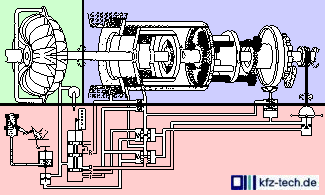Automatic 1
| Operating errors are almost impossible ... |
| N | Neutral |
| D | Drive |
| P | Park |
| R | Reverse |
The fully automatic gearbox determines the transmission ratio by itself. It selects the gear primarily according to the position
of the gas-pedal, the driving speed and the selector-position. The two first mentioned parameters are the more important ones. If e.g., the gas-pedal is kept in a constant position, and the speed increases (through
driving downhill), then the transmission control changes to the next higher gear. Putting one's foot down rather encourages the transmission to select a lower gear. In extreme situations in fact, also two or even three
speeds can be changed all at once.

In most fully automatic transmissions the gearbox drive shaft is connected, through a torque converter (above left) to the crankshaft and cannot be completely separated. Inside, planet sets (above center) and multiple-disc clutches (above right) are placed in the power flow. With the planet sets, one distinguishes between:
- sun-wheel, ring-gear and three
planet gears (1),
- sun-wheel, ring-gear and six planet gears (2),
- the combined planet set (3).
The planet set (1) makes possible together with two muliple-disc clutches that the amount of gear-speeds be doubled, or together with a muliple-disc clutch and a freewheel, a reverse gear. Planet set (2) with
multiple-disc clutch(s) provides only forward gears, planet set (3) allows, together with several multi-disc clutches and a freewheel, three forward gears and a reverse gear. More detailed descriptions of the individual
power profiles can be found here.
As a rule, the freewheel substitutes for a multiple-disc clutch. With this, changing from one particular gear to another can only be done by using a multiple-disc
clutch. Without the freewheel, when changing gears, always at least one clutch would have to be open and another closed.
The electronic regulation in the automatic transmission also has additional advantages apart from the possible troubleshooting. Thus, the communication is possible with the engine control device, perhaps through
the . This means that the transmission control device does not need it's own sensors for RPM, temperature and other measurements, in addition, commands
can also be given. Nowadays, it is usual that during the gear-change process, the ignition is shifted for a short time in the direction of 'retard', thus decreasing the strain.
An often misunderstood conception, is the 'kickdown'. This describes the occurence which is triggered when the gas-pedal is pressed to the floor. In this case, the automatic transmission changes down into the
lowest possible gear, this can also mean that gear-speeds are skipped. Contrary to widespread belief, this is not the only method of getting the transmission to downshift one or even more gear-speeds. This is also
possible without 'flooring' the gas pedal. 04/12